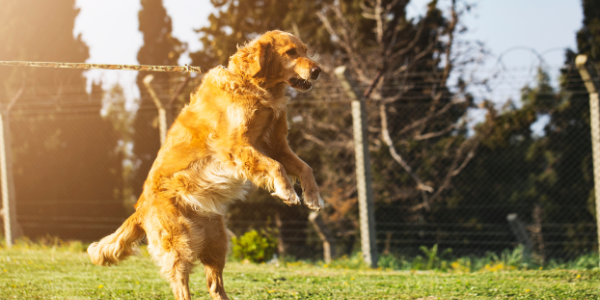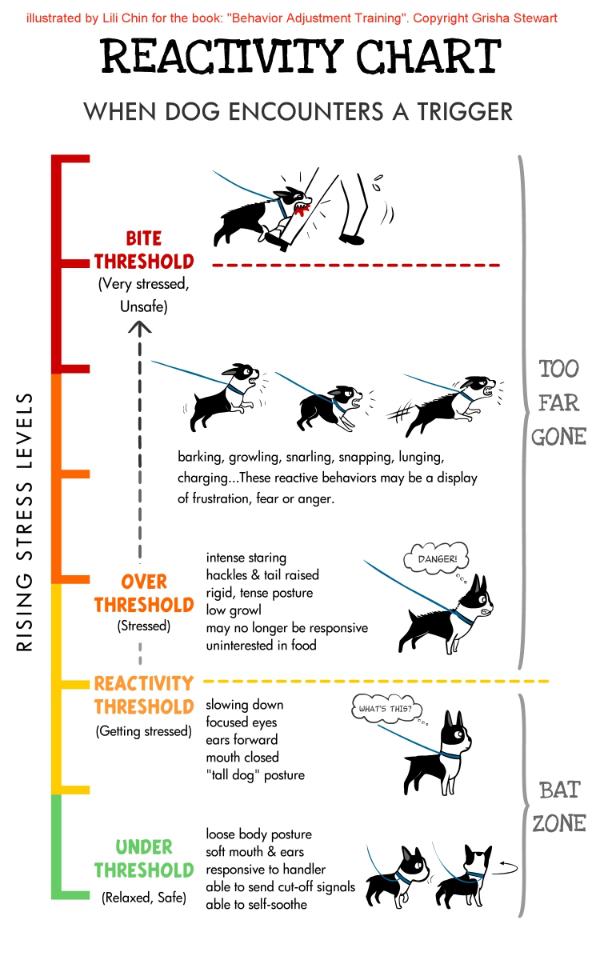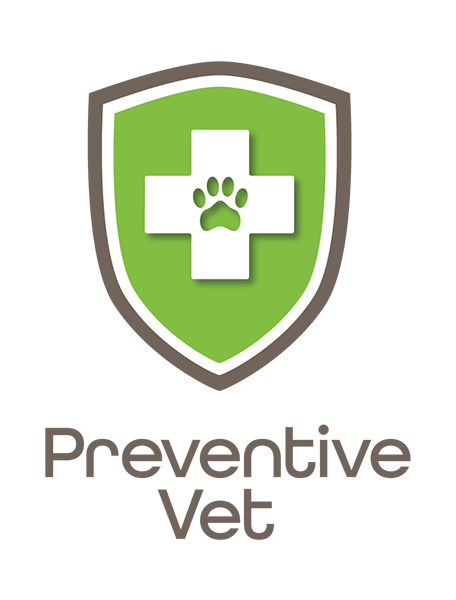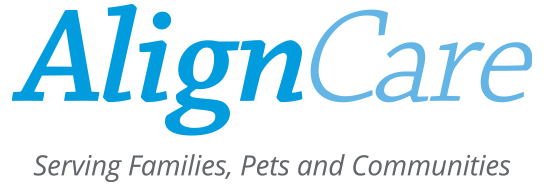If your dog barks and lunges while on leash, whether at people, other dogs, or other moving objects like cars or bicycles, they are exhibiting leash reactivity. These overreactions can be embarrassing, scary, and downright dangerous. Fortunately, you can help your dog learn how to calm down when on walks.
Quick Links

Dogs can become reactive on leash for a variety of reasons. Here are a few causes leash reactive behavior and things that can exacerbate reactivity:
Our mission is to help save dogs' and cats’ lives through our educational content. To support our efforts, this page may contain affiliate links. We earn a commission for qualifying purchases – at no cost to you.
Leash reactivity is the overreaction to the presence of something in the environment, called a "stimulus" or "trigger" when a dog is on leash. The trigger for leash reactivity can be people, dogs, other animals, or moving objects like buses, cars, bicycles, or skateboards. While most reactivity happens when a trigger comes into sight, in some cases, it can be caused by the sound or smell of a trigger, such as a dog barking in the distance.
The most common type of leash reactivity is fear-based reactivity, where a dog is afraid of the trigger and in an effort to avoid it will display aggressive behaviors. Making themselves look scary often works to make the trigger move away or leave, such as when a dog barks at another dog walking by, and the passing owner crosses to the other side of the street. Dogs learn by association. If barking makes the thing move away, they've just learned that barking is what they should do in the future to stay safe and feel better about the situation.
In fear-based leash reactivity, the leash prevents a fearful dog from running away — it removes the flight option, leaving your dog with the "fight" option. When given a choice between fight or flight, many dogs will prefer to run and avoid conflict. Conflict is expensive behavior and can result in injury or worse. So instinctually, dogs tend to prefer avoidance. But on a leash, they don't have that choice.
The next most common type of leash reactivity is frustration-based reactivity. Compared to fear-based reactivity, the dog wants to get closer to and interact with the stimulus. The leash again plays a big role here, acting as a barrier to the dog and preventing them from getting what they want. This frustration builds up and if a dog has a low tolerance for frustration or doesn't know what to do with their big feelings, it results in reactive behaviors.
If not addressed or if the reactive behaviors are punished, frustration-based reactivity can shift into fear-based reactivity. This happens because with repetition, the appearance of a trigger predicts the negative emotional state of frustration or the trigger predicts a punishment. The trigger becomes something the dog wants to avoid because it has a negative association.
Leash reactivity does not automatically mean a dog is aggressive. In the examples of fear or frustration-based reactivity, the goal of the dog is not to cause harm to another. Instead, they either want the trigger to go away (fear) or want to interact with the trigger (frustration).
Reactivity based on predation towards animals such as birds or rabbits also does not fit neatly into an "aggressive" label. Dogs have an innate predatory drive, but displaying prey drive is not typically classified as aggression.
However, in rare cases, leash reactivity can be a result of conflict-seeking behavior, where a dog seeks out a trigger and intends to cause harm. These dogs tend to exhibit specific aggression-based behaviors, whether on or off leash. These dogs require immediate support from a certified professional behavior consultant or veterinary behaviorist.

Take your dog to your veterinarian to rule out any pain or medical issues that could be contributing to reactive behavior. This is important because if there are pain or health issues, all of the behavior modification and training you do will only go so far (if anywhere at all) if a contributing medical issue is not treated.
Sit down and make a list of what triggers your dog's leash reactivity and estimate the distance threshold (the distance from the trigger where your dog will exhibit fixation towards the trigger or start reacting).
Examples of Triggers and Thresholds:
This step is important because it will determine how best to manage your dog's environment (step 3) and inform your behavior modification training (step 5).
If it's difficult to determine your dog's threshold, it's beneficial to work with a certified professional dog trainer or behavior consultant. They can help you set up a baseline test to identify your dog's threshold levels and walk you through counterconditioning steps.
Once you have defined your dog's triggers and threshold, that means you can now adjust your walks to prevent your dog from going "over threshold" (reacting). This step is crucial to success!
Every time your dog rehearses reactive behavior, it is making that behavior more likely to happen in the future. It's what could be considered a self-reinforcing behavior, especially in the case of fear-based reactivity. If reacting makes the scary thing go away, then your dog will react again the next time to get the result they want. For this reason, we want to prevent rehearsal of the behavior.
What's also happening is that your dog's brain is experiencing a surge of cortisol, the stress hormone, when they go over threshold. It takes time for your dog's body to flush excess cortisol and return to normal levels. We want to reduce these stress levels as much as possible for effective behavior modification, which means we want to avoid these surges of cortisol as much as possible.
When your dog is out with you on leash, pay close attention to the environment and maintain a distance further than your dog's threshold.
Example: If they usually start barking at another dog when they are 30 feet away, then you must stay 31+ feet away.
Managing the environment can be difficult, especially if you live in a city environment or an area where your dog's trigger appears frequently. You may need to change what time you take your dog on walks to avoid triggers. Perhaps you don't go for walks in your neighborhood, but instead, take your dog in the car to a quiet area for walks. Or, in some cases, you may need to stop going on walks altogether while you work on treating their reactivity.
If you stop taking walks with your dog, you can substitute mental enrichment and other types of exercise to meet their overall activity needs.
One way to reduce stress and anxiety is to make sure your dog is getting sufficient physical exercise and mental enrichment. While every dog's physical exercise needs are unique based on size, breed, age, and health, a good rule of thumb is a minimum of 30 minutes a day.
To increase physical exercise while reducing walks (if needed for management), incorporate at-home exercise such as playing with a flirt pole or playing fetch or tug. A popular option for many owners of leash-reactive dogs is to use a yard rental service called Sniffspot, where you can find and book private yards for your dog to run around and sniff. Not only does this provide physical exercise, but a new environment provides a satisfying enrichment opportunity as your dog takes in new sights, sounds, and smells.
Increase mental enrichment by incorporating interactive dog feeders and puzzles for every meal, practicing fun training skills in multiple short training sessions every day, and providing appropriate edible chews. If your dog likes to dig, set up a designated dig pit for them to use. You're looking for ways to give them an outlet for natural dog behaviors – to just be a dog. Three activities, in particular, are naturally calming for dogs: licking, chewing, and sniffing.
Find inspiration for increasing your dog's enrichment in Dog Enrichment: Toys, Games, and DIY Ideas.
Once management is in place, you can begin to practice the key part of leash reactivity treatment. Counterconditioning works to change your dog's emotional association with their trigger. When they feel better about the trigger, their actions reflect this.
When practicing the exercises below, it is imperative that your dog stays below threshold. If the trigger is too close or too intense, they will not be able to learn. It's helpful to create training setups to practice these exercises at first so you have a chance to practice your timing. Working with a certified dog trainer provides you with an easy way to have training setups with a helper dog or ask a friend or family member who has a calm dog to act as your decoy.
For these counterconditioning exercises, you will need a food treat that your dog finds high value and that they don't get at any other time other than when triggers are present. Some examples of high-value treats to use: turkey hotdogs, freshly boiled chicken breast, low-fat string cheese, or a squeeze tube of soft treat slurry (such as the Bark Pouch treat squeeze option).
This first exercise is strictly about changing emotional associations, not about what your dog "does" when they see their trigger.
This is a continuous feed. If using individual treats, feed them in a steady stream, one after another after another, until the trigger is out of sight. Do not ask your dog to do anything when practicing this exercise.
The timing here is important. Do not start feeding before the trigger appears. We want the trigger to predict a high-value event. We do not want the dog to associate treats with the impending appearance of something they are frightened of or overexcited by, as this can have unintended consequences of a negative association with treats.
Find more in-depth tips for practicing Open Bar, Closed Bar here.
Here are two videos showing the Open Bar, Closed Bar Method:
This second exercise builds on the previous exercise, by building on the positive emotional association and adding in the next layer of teaching the dog what to "do" when they see a trigger.
First Step: Engage
In this step of the game, you are reinforcing your dog for noticing the trigger. Looking, but not overreacting, is an acceptable behavior!
Second Step: Disengage
Only move to this step after a few days of practicing the previous step.
This step of the game is reinforcing self-interruption. Disengaging and looking away from the trigger is a great choice and you want to reward your dog for making that choice.
Learn more about how to play the engage-disengage game with your dog.
Here are two videos showing the Engage-Disengage Game:
Beyond counterconditioning, there are a few other methods used by certified dog trainers and behavior consultants for leash reactivity. Examples include Behavior Adjustment Training (BAT), Constructional Aggression Treatment (CAT), and the Play Way.
Beyond counterconditioning to treat leash reactivity, there are a variety of training skills that will support you in managing the environment and keeping your dog under threshold. These include:
You may also consider training your dog to wear a basket muzzle. Basket muzzles are typically recommended for leash reactivity cases where a dog is likely to redirect towards their handler or reactive towards people and dogs and have a low distance threshold (meaning they do not react until very close to the trigger). Not only does a basket muzzle provide safety and reduce bite risk, but it also acts as a social cue to others that they should not approach your dog or allow their dog to approach your dog.
Learn how to train your dog to wear a basket muzzle here. Muzzle training takes a few days to a couple of weeks to teach your dog to wear it comfortably.
Every dog's treatment time is unique to them and their circumstances. While it's impossible to give a general treatment time because of this, you will want to look for signs of progress within the first two to three weeks of implementing management and counterconditioning. If there is no progress noted, then it's important to carefully consider threshold management and other parts of the behavior modification process and make changes.
The time it takes for a dog to overcome leash reactivity depends on:
Punishing a dog for reactive behavior is most likely to increase their reactivity over time. Why? Dogs learn by association, and if their trigger predicts something unpleasant or negative happening to them, then the negative emotional association increases. Negative emotions drive behaviors like barking, lunging, or biting.
While using a collar correction may stop their reactive behavior in the moment (because they want the pain to stop), it is only suppressing behavior. It is not addressing the underlying cause of their reactivity, whether fear or frustration. Especially for dogs who exhibit frustration reactivity, adding punishment can shift their reactivity into fear-based aggression.
Avoid using aversive tools such as choke, prong, or shock collars. Do not yell, hit, or yank your dog if they exhibit reactive behavior. Remember, your dog is struggling in the situation and your job is to manage their environment so they feel safe and learn what to do instead.
The Pet InfoRx® is made possible, in part, through our partnership with AlignCare®.


© Preventive Vet. All rights reserved. PreventiveVet.com
